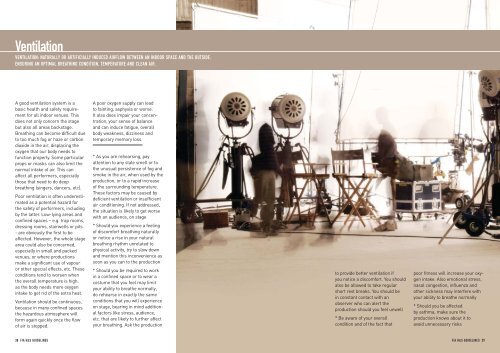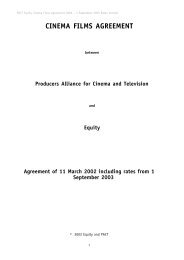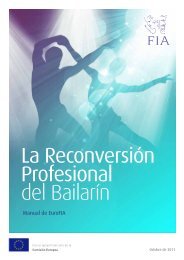ACTSAFE
landscape version - the International Federation of Actors
landscape version - the International Federation of Actors
- No tags were found...
You also want an ePaper? Increase the reach of your titles
YUMPU automatically turns print PDFs into web optimized ePapers that Google loves.
Ventilation<br />
VENTILATION: NATURALLY OR ARTIFICIALLY INDUCED AIRFLOW BETWEEN AN INDOOR SPACE AND THE OUTSIDE,<br />
ENSURING AN OPTIMAL BREATHING CONDITION, TEMPERATURE AND CLEAN AIR.<br />
A good ventilation system is a<br />
basic health and safety requirement<br />
for all indoor venues. This<br />
does not only concern the stage<br />
but also all areas backstage.<br />
Breathing can become difficult due<br />
to too much fog or haze or carbon<br />
dioxide in the air, displacing the<br />
oxygen that our body needs to<br />
function properly. Some particular<br />
props or masks can also limit the<br />
normal intake of air. This can<br />
affect all performers, especially<br />
those that need to do deep<br />
breathing (singers, dancers, etc).<br />
Poor ventilation is often underestimated<br />
as a potential hazard for<br />
the safety of performers, including<br />
by the latter. Low-lying areas and<br />
confined spaces – e.g. trap rooms,<br />
dressing rooms, stairwells or pits<br />
- are obviously the first to be<br />
affected. However, the whole stage<br />
area could also be concerned,<br />
especially in small and packed<br />
venues, or where productions<br />
make a significant use of vapour<br />
or other special effects, etc. These<br />
conditions tend to worsen when<br />
the overall temperature is high,<br />
as the body needs more oxygen<br />
intake to get rid of the extra heat.<br />
Ventilation should be continuous,<br />
because in many confined spaces<br />
the hazardous atmosphere will<br />
form again quickly once the flow<br />
of air is stopped.<br />
A poor oxygen supply can lead<br />
to fainting, asphyxia or worse.<br />
It also does impair your concentration,<br />
your sense of balance<br />
and can induce fatigue, overall<br />
body weakness, dizziness and<br />
temporary memory loss.<br />
* As you are rehearsing, pay<br />
attention to any stale smell or to<br />
the unusual persistence of fog and<br />
smoke in the air, when used by the<br />
production, or to a rapid increase<br />
of the surrounding temperature.<br />
These factors may be caused by<br />
deficient ventilation or insufficient<br />
air conditioning. If not addressed,<br />
the situation is likely to get worse<br />
with an audience, on stage<br />
* Should you experience a feeling<br />
of discomfort breathing naturally<br />
or notice a rise in your natural<br />
breathing rhythm unrelated to<br />
physical activity, try to slow down<br />
and mention this inconvenience as<br />
soon as you can to the production<br />
* Should you be required to work<br />
in a confined space or to wear a<br />
costume that you feel may limit<br />
your ability to breathe normally,<br />
do rehearse in exactly the same<br />
conditions that you will experience<br />
on stage, bearing in mind additional<br />
factors like stress, audience,<br />
etc. that are likely to further affect<br />
your breathing. Ask the production<br />
to provide better ventilation if<br />
you notice a discomfort. You should<br />
also be allowed to take regular<br />
short rest breaks. You should be<br />
in constant contact with an<br />
observer who can alert the<br />
production should you feel unwell<br />
* Be aware of your overall<br />
condition and of the fact that<br />
poor fitness will increase your oxygen<br />
intake. Also emotional stress,<br />
nasal congestion, influenza and<br />
other sickness may interfere with<br />
your ability to breathe normally<br />
* Should you be affected<br />
by asthma, make sure the<br />
production knows about it to<br />
avoid unnecessary risks<br />
38 FIA H&S GUIDELINES<br />
FIA H&S GUIDELINES 39







